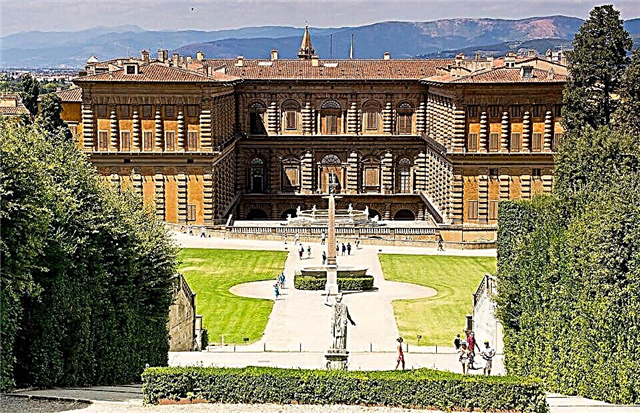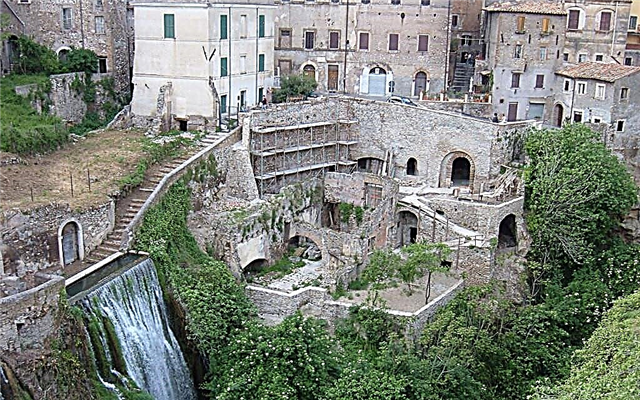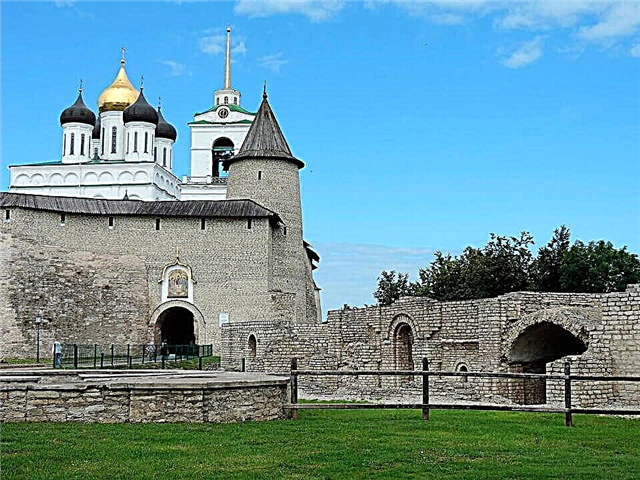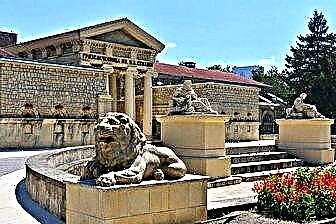Against the background of the more promoted Kislovodsk and Pyatigorsk, the city of Essentuki may seem too small and unremarkable. But this is only at first glance - the town is so cozy and charming that you won't want to leave it. Of course, the entire infrastructure revolves around healing and mineral springs. All conditions have been created for tourists: drinking galleries, a magnificent park where you can walk for hours, picturesque architecture of the 19th - early 20th centuries.
They go to Essentuki to restore health and enjoy the curative climate of the Caucasus. If there are not enough local attractions, then it will not be difficult to get to other KMV resorts from here, since they are all connected by a public transport network.

The best hotels and hotels at affordable prices.
from 500 rubles / day
What to see and where to go in Essentuki?
The most interesting and beautiful places for walking. Photos and a short description.
Mineral springs
Essentuki is a balneological resort known since the time of tsarist Russia, which is famous for its mineral springs. For the first time they were discovered by Cossack settlers. It was thanks to them that the development of tourism in the region became possible. The keys are concentrated in the resort area of the city, as a rule, on the territory of sanatoriums. The famous "Essentuki-4" and "Essentuki-17" are located in the Kurortny Park.

Mud bath named after Semashko
Historical mud baths of the early XX century, located in a magnificent building in the neoclassical style - the most impressive architectural monument of Yessentuki. All buildings of the institution, around which the Resort Park is spread, occupy half a block in the city center. The building was built according to the project of the St. Petersburg architect E.F.Shretter. The work was completed in just 2 years, in spite of the outbreak of the First World War. Initially, the hospital was named after Tsarevich Alexei.

Fountain in the Central Square
In August 2007, the Essentuki Central Square was decorated with the largest fountain in the south of Russia - its total area is 400 m². It does not have a traditional reservoir for collecting water - the jets are pouring directly from the paving stones. To the accompaniment of musical accompaniment, streams rise upward, forming various forms in the air. When the fountain is not working, it is quite difficult to guess about its presence in the square - this is such an architectural trick.

Spa park
The park was laid out in a swampy area, where the ground did not dry out even in the hot summer. The initiative to create a recreational zone belonged to M.S.Vorontsov. The arrangement dragged on for many years, the more beautiful was the result: trees, flowering flower beds, narzan galleries, gazebos and sculptures, even a theater building was built! Throughout the 20th century, the appearance of the park continued to improve; today it is a real resort oasis.

Shpakovsky Museum of History and Local Lore
The museum is located in the historic center of the city in a late 19th century mansion. It was founded in 1963. At the moment, the exposition is located in six rooms and is divided into thematic sections: the history of the development of the resort, climate, flora and fauna, antique furniture, archival photographs and documents, as well as materials dedicated to famous personalities connected in one way or another with Essentuki.

Monument to the Cossacks - the founders of Essentuki
The monument was erected in 1997 on the Renaissance Square next to the memorial cross, which appeared here seven years earlier. The sculpture represents the figure of a Cossack in a Circassian coat, burka and hat, surveying his future possessions with a master's gaze. It is fixed on a stone pedestal, around which there is a small flower bed. The local Cossack community is monitoring the improvement of the square and the safety of the monument.

Victory Park
The park was founded in 1903; it became the second green zone in the city after Kurortny. Initially, the territory was designed in the best traditions of the English landscape style. In Soviet times, it fell into disrepair, as the lawns were hardly looked after. In the 1970s, landscaping work was carried out here, and at the same time the "Eternal Flame" stele was installed. In the 2000s, walking alleys were restored, flower beds were laid out and an amusement area was organized.

Theater-Park
Theater-Park is a concert hall on the territory of the Kurortny Park, built in 1901 next to the Narzan Gallery. For many decades, it was the only musical venue of Essentuki, where orchestras, ballet stars and singers performed. After the opening in 1980 of the hall to them. F.I. Shalyapin, the institution was closed, and the magnificent building in the style of late classicism began to collapse. After the restoration, a hotel and a restaurant were opened on its territory. Near the theater-park there is a picturesque fountain with beautiful evening illumination.

"Zero kilometer of love"
A monument dedicated to all lovers, opened in 2011 on Teatralnaya Square. It is a column on top of which Amur is peacefully sleeping. Near the stele on the paving stones there is a composition made of marble - two hearts in a circle and the inscription “Zero kilometer of love”. There are benches near the monument, walking paths and flower beds are laid out.
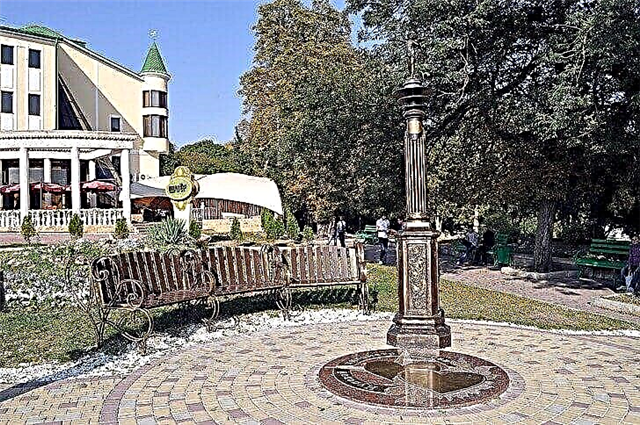
Musical gazebo "Rococo"
The gazebo is located in the Spa Park and is one of the most visited attractions of this place. It is made of cast iron using the art of forging. The fence, cornices and roof are decorated with finely carved ornaments. The gazebo got its name because musicians performed there until 1912. This glorious tradition has been revived today.

Gazebo "Oreanda"
"Oreanda" was built in 1912 in imitation of the Yalta rotunda, located in the village of the same name in the Crimea. It is a classic colonnade. Until 1917, there was a telescope here, and you could observe the stars. From the platform inside the pavilion, a magnificent panorama opens up to the Greater Caucasus Range and to the closer peaks - Beshtau and Mashuk.

Church of St. Panteleimon
The first building of the temple was erected in the 1880s, but with the advent of Soviet power, the church was closed and in the 1930s it was dismantled. In 1992, construction began on a new building with donations. The modern appearance of the church is in no way reminiscent of the historical one: the walls of the building are made of yellow bricks, window openings and entrance portals are decorated with multi-tiered arches.

St. George Monastery
Convent founded in 2006. The history of the monastery began with the construction of the Church of St. George the Great Martyr in 2003, built by volunteers with donations. After some time, the church hierarchs decided that a female monastic community should be formed here. The complex of buildings includes a temple, chapels, a residential building, a church shop and a bathhouse. The main shrine is a particle of the relics of St. George.
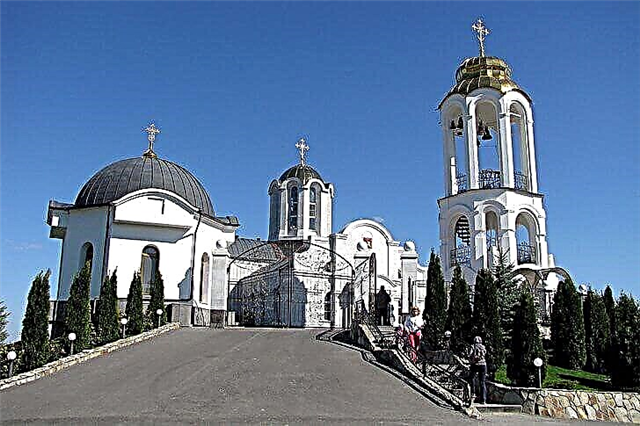
Church of St. Nicholas the Wonderworker
Picturesque wooden church of the XIX century, founded by the Cossacks and built by the Bernadazzi brothers. He worked under Soviet rule and was not ruined. Inside there are memorial plaques with the names of the Cossacks who distinguished themselves during the Russian-Turkish and Russian-Japanese wars in the 19th – 20th centuries, as well as a richly decorated five-tiered iconostasis. The walls are covered with light blue paint, which makes the church light and festive.

Rio de Caucasus
A large temple and park complex on the outskirts of Essentuki, created exclusively with private funds.On its territory there are many sculptural compositions revealing biblical themes; there is a mini-zoo for children. The central figure of the object is the 22-meter statue of Christ. The name of the complex speaks for itself, clearly referring to the Christ the Redeemer Monument in Rio de Janeiro.

Zander Institute of Mechanotherapy
The institution is located in an Art Nouveau building, erected at the end of the 19th century, which is strikingly different from all other city buildings. Here, special therapeutic simulators were invented, which worked according to the method of the Swedish doctor G. Tsandero. These devices are still used to massage the arms, legs and trunk, as well as to correct scoliosis and stretch the spine.

Bath building of Emperor Nicholas II
The building is located in the upper part of the Kurortny Park. At the end of the 19th century, even before the construction was completed, the baths, named after the reigning king, received the first visitors. The building was built in a classical style with baroque elements; in front of it there is a green lawn with landscape sculptures and a bowl of a fountain. Inside there are several dozen baths with healing mineral water.

Spring gallery number 17
Spring Gallery No. 17 is one of the oldest buildings in Essentuki, erected in the middle of the 19th century under M. Vorontsov on the site of a healing mineral spring. It is executed in the manner of English Gothic, diluted with elements of the Moorish style, designed by the architect S. Upton. Over time, additional buildings were added to the pavilion, where a reading room, a post office and a buffet were located.

Source gallery no. 4
A more modern gallery built in 1967. Here spring No. 4 comes to the surface, known throughout Russia due to its taste. The building is made in the style of Soviet minimalism: simple rectangular shapes, lack of decor, obligatory mosaic on the facade, symbolizing the friendship of peoples. Previously, a pavilion in the ancient Greek style was located above the source.
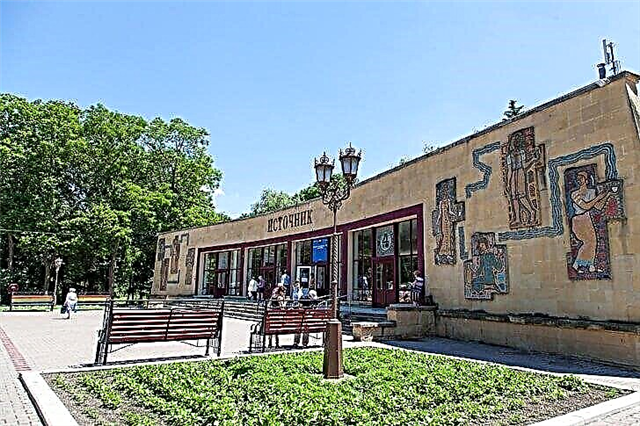
Drinking gallery "Five-thousanders"
The largest drinking gallery in Europe, with a capacity of up to 5,000 visitors. It is located on the territory of the Victoria sanatorium, one of the largest in the region. The building was erected in the 1990s. It is a round building with a glass dome in the middle, somewhat reminiscent of a modern sports arena. Here you can taste several types of hot and cold mineral water.



